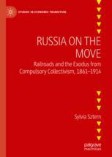Search
Search Results
-
Was Stalin Necessary? Railroads and the Crumbling of the Obshchina in Tsarist Russia
Russian agriculture in Tsarist times was a stagnant, ossified enterprise and its practitioner, the muzhik (peasant), was listless, indolent, driven...
-
The Railroads and the Metamorphoses of the Mir: Westernizer and Slavophile Conceptions Revisited
The NIE/AEI model suggests complementarity between the Slavophile and Westernizers’ conception of the commune. The founder of the latter school,...
-
Epilogue
The Kantian intuition that inspired this monograph is twofold. First, it was a tacit cultural and economic transition, spanning over half a century,...
-
Measurable Power: Railroads, Literacy, and the Crafts Artel—Hierarchy in Disarray in Late Imperial Russia
In this chapter, I propose a way to measure the heretofore unexplained techno-cultural “translation” of the traditional rural non-agricultural...
-
Peasantry and Land in Industrializing Late Tsarist Russia
The challenge put forward in this chapter was briefly mentioned in Chap. 4 : the emergence of...
-
Industrialization as a Precipitant of Tensions Between Tsardom and Nascent Civil Society
Russia in 1861–1906 was burdened with the costs of its own dictatorship, originating in hierarchies of coercion that came about when the state...
-
From Hierarchy to Egalitarianism: From Gerschenkron to Gregory—Deduction and Induction from NIE/AEI Complementarity and the Regulationist Model
Russia’s historical transition, described in this monograph, and the recent one—dating from 1985 or so—have one feature in common: a shift from...
-
Through the Lenses of Theory: New Institutional Economics and American Evolutionary Institutionalism—Railroads, Specialization, and Democracy in Late Tsarist Russia
In this chapter, I investigate the applicability of two theoretical perspectives, mentioned in previous chapters without much elaboration, that I...
-
Individualism and Collectivism: Measuring the Transition to Modernity in Tsarist Russian Peasant Society, Penza Province, 1913
Here I introduce an often-overlooked production factor, a vital one at that—human dignity as the determinant of human performance. The aspect of...
-
From Janus to Janus: Peter I, Nicholas II, and Industrialization
In this chapter, I expose my thesis, and the evidence behind it, to the tension between Alexander Gerschenkron’s notion of abstract continuity in...
-
Secularization and Pious Subversion: To the Constitution by Rail
Here I investigate the crucial role of railroads in Russian modernization from by focusing on additional aspects of the institutional change that...
-
Russia on the Move: Railroads and the Exodus from Compulsory Collectivism, 1861–1914
The advent of the railroad in Tsarist Russia in 1842 would precondition the institutions of the Russian autocracy in its final decades. In this...
-

-
Cliometric Approaches to Central, East, and South-East Europe
Following a brief historiography of cliometric research on the Eastern half of Europe and a summary of six pioneering publications, this chapter...
-
Cooperativism and Self-Management in Marx, Engels, and Lenin
A certain consensus exists in literature regarding human beings’ tendency for cooperation or self-management. Iñaki Gil de San Vicente refers, for...
-
Social Mechanisms Governing the Informal Transactions between Russian IT Managers
While the previous chapter dealt with the contents of Russian managers’ informal transactions (e.g. information, advice, money), this chapter...
-
Socio-economic Differentiation of the peasantry
This chapter has two purposes: first, to compare the level of differentiation among the peasantry in 1909–13 and the mid-1920s; and secondly, to...
-
The Peasant Economy and the Soviet System, 1917–29
The victory of the Bolshevik revolution in a predominantly peasant country posed a fundamental dilemma to the makers of Soviet economic policy. In...
